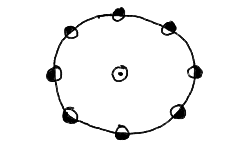
Seeds: Chapter 3
Next Lecture - Cycles of the Moon and Tides
Review of Important Points from Previous Lecture
In the previous lecture, I introduced the concepts of sidereal time using the distant stars, and solar time using the Sun as clocks as the Earth rotates. Demonstrating why the solar day is 4 minutes longer than the sidereal day is difficult, and I now present the arguments again in a slightly different manner.
I am also using this time to introduce the concept of a frame of reference, that will be very important later on when we discuss Einstein's theory of relativity and cosmology. Whenever we draw a map of something, be it the Earth's surface, or celestial sphere, or the orbit of the Earth as seen from above, or anything else, we are drawing it as seen from a particular point-of-view, in other words, in coordinates locked to a particular frame of reference. When I draw the Earth's orbit as seen from "above", I am using a frame of reference fixed to the positions of the distant stars. This is the reference frame we will use most often here.
I would first like to demonstrate that even if the Earth were locked facing the Sun so that it was always the same solar time, that the celsestial sphere, and thus the distant stars, would be seen to rotate once during the year. Shown below is a rough diagram illustrating two differently colored hemispheres of the Earth locked facing the Sun. Note that the dark colored half rotates once relative to our point-of-view of the stars.

Thus, even if there is no solar day, there is one sidereal day. We now draw the same figure, but with the dark half making two turns with respect to the stars (us looking down on it).
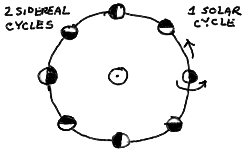
We now see that our "Earth" makes one complete rotation with respect to the Sun, as the white half faces the Sun at the right, and the dark at the leftmost part of the orbit. The year now is one solar day long, but two sidereal days long! It is easy now to see how this will generalize to more days. Q: Try drawing the same picture for 3 sidereal days in the year (Hint: divide the orbit up into 12 earths on the orbit instead of 8). There will always be one more sidereal rotation than solar rotation. If there are 365 solar days in the solar year, then there will be 366 sidereal days in the solar year. Thus, the solar day must be (366/365) x sidereal day!
This also shows the importance of drawing pictures to help you understand the geometrical aspects of astronomy. This will become very useful also for understanding the phases of the moon (compare the pictures above to the one I will draw next lecture), and eclipses.
I will now make a third set of drawings to show the relationship between the sidereal and solar day. I will zoom in on a (greatly exaggerated) step of one day in the orbit of the Earth. We see on the left panel, after one sidereal day, the earth is in the same orientation to us (the stars) as it was at the beginning. The little arrow meant to represent an observer looking upward is pointing in the same direction. But note that at the end of the day it is no longer pointing at the Sun! This is because our orbit has carried us around a little ways, and the Sun now appears in a different direction (a little eastward). To bring our arrow to point at the Sun again, we have to move a fraction of a rotation farther. From geometry, we know that the angle between the first earth, the Sun, and the second earth, which is just 1/365 of a circle (the orbit), must be equal to the angle between the Sun, the second earth, and the direction to the distant star the second arrow is pointing to. This is 1/365 of a circle then, or 1/365 of a sidereal day (a circle of the earth). Thus we get the panel on the right:
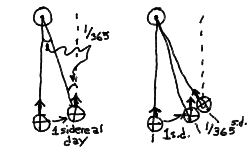
If you have trouble seeing the angles, you might want to review a book on elementary geometry. We will be doing this sort of thing fairly often.
Precession of the Earth's Axis
The rotation of the Earth makes it behave like a top or gyroscope spinning in space. If the Earth were a uniform perfect sphere, then the rotation axis would remain pointed in the same direction for all time, just like a gyroscope in a spacecraft guidance system. However, the Earth is not perfectly spherical - it is made of a slightly uneven distribution of rocks, magma, and an iron core, with a tasty coating of fauna, flora, and air. The Earth's crust, though made of rock, is not perfectly stiff, and the extremely fast rotation causes it to flatten slightly at the poles relative to the equator.
The rotation speed of the Earth (a circumference of 40000 km spinning around in 24 hours, or about 1700 km/hour) causes centrifugal forces on the equatorial crust to pull those regions outward. This shape of a squashed sphere is called an oblate spheroid. The equatorial diameter of the Earth is about 43 km larger than the polar diameter.
Because the Sun and Moon are not in the equatorial plane of the Earth, this equatorial bulge does not line up with the gravitational forces caused by the Sun and Moon. These forces acting upon the spinning Earth cause the rotation axis to change in orientation, or precess, much like gravity causes a top to precess its spin axis. Precession carries the rotation axis around in a circle or cone about the axis defined by the ecliptic poles, at the constant inclination angle of 23.5 degrees.
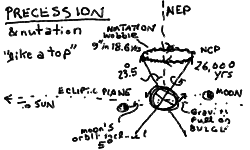
Because the forces of the Sun and Moon act to "upright" the spinning Earth, the precession is in the direction opposite to the spin. In the case of a top, gravity is trying to pull it over, so the precession is in the same direction as the spin.
The period of the precession is one circuit every 26,000 years. This means that the celestial longitude (Right Ascension) of the stars will change at the rate of 50" every year.
The plane of the Moon's orbit is inclined at 5 degrees to the ecliptic plane. This slight mismatch causes a wobble in the precession, or nutation of about 9.2" with a period of 18.6 years.
Motions of the Planets - First Look
The other planets of the solar system revolve about the Sun in roughly the same plane as the Earth's orbit. Thus, they appear on the sky confined to within a few degrees of the ecliptic. The orbit the Sun in the same direction as the Earth (appearing counter-clockwise as viewed from the north ecliptic pole). Thus, they appear to move Eastward along the ecliptic like the Sun, though with periods ranging from 2 years for Mars to over 90 years for Pluto. The orbits are nearly circular, except for Pluto and to a lesser extent Mercury.
The inner planets Mercury and Venus always appear in the sky near the Sun. For example, Mercury is never more than 28 degrees from the Sun in the sky. This is just the orbit as viewed from the Earth:
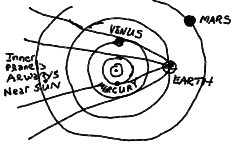
The angular distance a planet appears from the Sun is called the elongation. Venus also appears close to the Sun in the sky, either setting a few hours after sunset as the "Evening Star" or rising a few hours before sunrise as the "Morning Star". Q: What is the maximum elongation of Venus?
Go to Previous Lecture ---- Go to Next Lecture
Back to the Lecture Notes Index
Back to the ASTR001/Sec3 Page
Steven T. Myers - Last revised 25Jan96